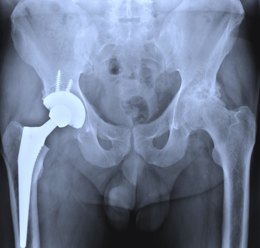Discomfort in the groin region, predominantly is courtesy of an unintentional pull or stretch of the thigh muscles. However, if the pain experienced seems to pullulate or radiate to other sites of the body, the cause may step beyond the common.

Groin pain is caused by disruption of the soft tissue that affects an area of the groin near the genitalia. This region is also called the 'inguinal region'. A tissue disruption, usually is called a sports hernia, and the medical term for the said condition is 'inguinal disruption'.
The Causes of Pain
❒
Hernia: The organ occludes through the cavity's wall that constitutes the organ.
❒
Kidney stones: A solid mass formed in the kidneys, through the aggregation of minerals in the urine.
❒
Orchitis: The inflammation of one or both testicles
❒
Groin swelling: A lump-like formation at the meeting point of the thigh and abdomen.
❒
Spinal disc disease: Degenerative disc disease, where the fibrous discs are unable to cushion the vertebrae.
❒
Referred pain: Pain that radiates and does not localize itself in the region that is actively affected.
❒
Enlarged lymph glands: This is the enlargement of one or more lymph nodes.
❒
Epididymitis: Inflammation of the epididymis; a tubular structure connecting the testicle with the vas deferens.
❒
Testicular torsion: This is, when the spermatic cord twists, causing a sort of truncation in the blood supply.
❒
Leydig cell tumor: A tumor of the testicles that is found to develop from the leydig cells that release testosterone.
Other causes responsible for groin pain are as follows:
❒ Testicular injury
❒ Scrotum pain
❒ Pelvis fracture
❒ Swollen groin lymph nodes
❒ Muscle pull
❒ Hip conditions, like arthritis, fracture, gout, or dislocation.
❒ Certain medications like Android Oral, Striant, Testopel, AndroGel, and Virilon.
The Major Indicants
❒ Pain, usually is initiated by running, changing direction, accelerating, and kicking.
❒ Discomfort occurs in the lower abdomen, which radiates through the inner and upper thigh.
❒ Pulsating pain is experienced after waking up in the morning and post an exercise session.
❒ Pain can be diffused, severe, or sharp.
Diagnostic Tests
►
Physical examination: If swelling is observed in the groin, it is an evidence of groin pain. If this is not clearly visible, the person is requested to cough. The lump may then be visible. In case the lump dilates with coughing, while a cough impulse occurs, chances are, it is an inguinal hernia. If the skin overlying the groin lump appears vermilion, it indicates a strangulated hernia or abscess. If the lump is reducible, it indicates femoral or inguinal hernia. The pulsating of the lump suggests femoral artery aneurysm.
►
Urine tests: Urinalysis and urine microscopy is conducted. Swab and culture of the base of any genital lesions is performed in order to diagnose genital herpes, chancroid, and syphilitic ulcer.
►
Radiological investigation: It involves Arteriography, Venography or Doppler ultrasound, CT scan of the pubic symphysis, Bone scan, and X-ray of the pelvis and lumbar spine.
►
Blood tests:Complete blood count and ESR with Renal function tests are also performed.
Call Your Doctor When ...
✆ The pain is fulminant and persistent in nature.
✆ The scrotum looks swollen and elicits a burning sensation.
✆ The appearance of the groin area has undergone changes; i.e., the skin in the region looks and feels different.
✆ You find traces of blood, while urinating.
✆ Only one testicle succumbs to pain and discomfort for a long period.
Symptomatic Treatment
► As unresolved chronic pain in the groin, generally is due to ligament laxity in the pubic symphysis joint, a potent solution is to strengthen the joint with Prolotherapy. It is an efficient treatment for repairing tendon, ligament, and cartilage damage.
Prolotherapy stimulates the body and repairs the painful regions. This induces a mild inflammatory reaction in the weakened ligaments and cartilage. Pain is effectively reduced as this treatment attacks the fibro-osseous junction -- a region having several sensory nerves. Additionally, the tissue-strengthening process and pain relief by Prolotherapy is permanent.
► In terms of treatment, using the
R.I.C.E. method serves the purpose. Rest, Ice, Compression, and Elevation is what becomes the need of the hour, when one seeks to derive relief from severe pain in the groin region. Activities that aggravate the condition should be avoided. Indulging in any form of sports must be barred for sometime.
You must keep a therapist in the loop, when you plan to resume sports. If you are not feeling absolutely thorough with yourself, drop the idea of doing so. There should be no pain or swelling affecting the area. There might be instances, where you feel completely energetic; however, you may feel deficient in strength and vitality. Make sure you experience a complete range of motion and are at the peak of flexibility.
Disclaimer: The article published herein, is meant to accomplish pedagogical purposes only. The recommendations mentioned hereby may not be generically applicable. The information, by no means, intends to supplant the diagnosis and advice imparted by the medical practitioner.


 Groin pain is caused by disruption of the soft tissue that affects an area of the groin near the genitalia. This region is also called the 'inguinal region'. A tissue disruption, usually is called a sports hernia, and the medical term for the said condition is 'inguinal disruption'.
Groin pain is caused by disruption of the soft tissue that affects an area of the groin near the genitalia. This region is also called the 'inguinal region'. A tissue disruption, usually is called a sports hernia, and the medical term for the said condition is 'inguinal disruption'.